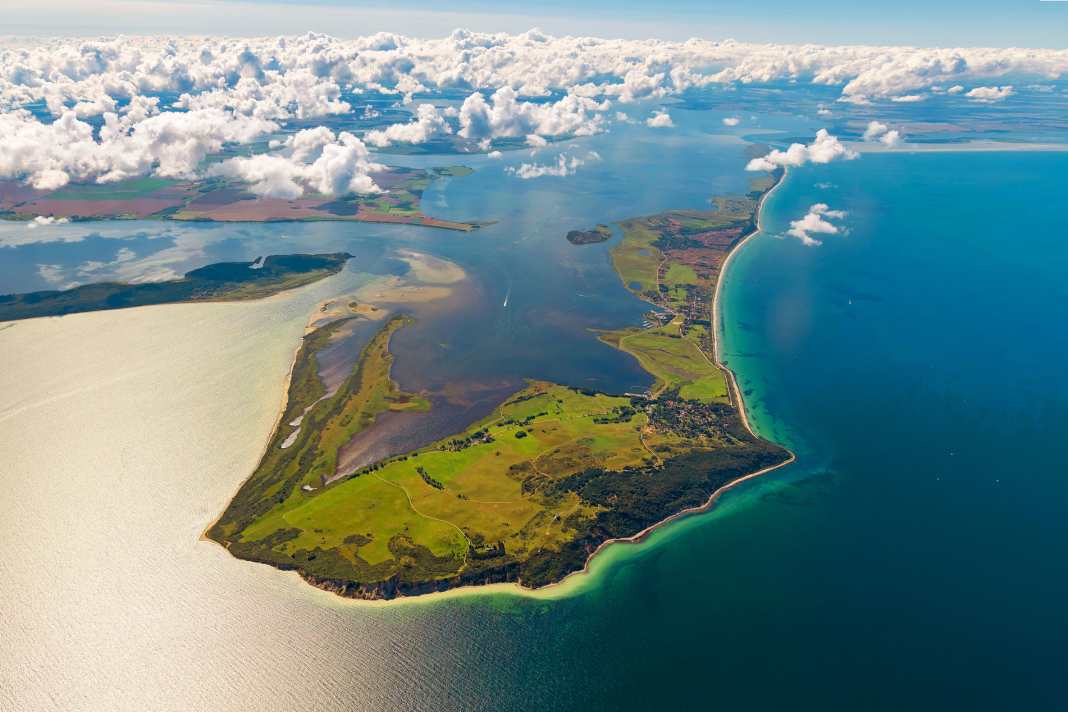





A lively tourist metropolis with a modern full-service marina and an entertaining shore programme or would you prefer a cosy jetty somewhere in the middle of nowhere, quiet, green and far away from the hustle and bustle? There are over a hundred variations of both types of harbour, in the most diverse gradations, along the German Baltic coast and its offshore islands. But what is it that makes one or other of them the dream harbour? No one can provide a universal answer to this question. This also applies to the members of the YACHT editorial team, most of whom are travelling on our home waters with their own keel. And that's a good thing!
After all, it prevents certain popular places from being overrun - and subsequently losing their charm, which is the reason why sailors head for them. It also opens up the opportunity to broaden your own horizons - by deviating from the usual routes and occasionally charting new courses. On the following pages, we show you where these might lead. There we present our harbour highlights. The selection is entirely subjective and by no means exhaustive. But from start to finish, it contains personal recommendations that come from the heart. And who knows, maybe you'll find your new favourite port among them.
In this article:
- Kappeln - in the centre of life
- Langballigau - a gem on the edge of the fjord
- Arnis - a small town on a grand scale
- Flensburg - golden light at the end of the fjord
- Kühlungsborn - deep-sea feelings for a sundowner
- Krummin - as if not of this world
- Orth - Pearl in the Fehmarn Sound
- Timmendorf on Poel - ready for the island
- Stralsund - maritime microcosm
- Schleimünde - an island with a connection
- Warnemünde - turning point on the Alter Strom
- Heiligenhafen - boomtown with unobstructable nature conservation magic
- Rerik - between binnen and buten
- Nature and culture in Kloster (Hiddensee)
- Lippe - a gem in the middle of nowhere
Kappeln - in the centre of life
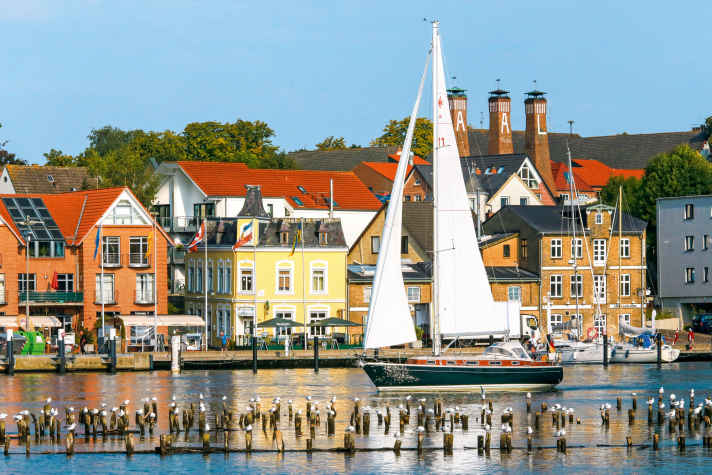
There are numerous harbours and mooring options around the town on the Schlei - but a highlight for guest sailors is the town harbour north of the bridge. If you get a place here, you are right in the middle of the action: in front of the bow the promenade with cafés and restaurants, behind the stern the lively fairway, opposite the herring fences populated by seagulls, which are typical of the region.
Kappeln takes its name from its landmark, St Nicholas' Church in the centre, whose spire towers far above the houses. The town used to live from trade and fishing, but today tourism is its core business - on land and on water. When the two-winged Schleibrücke bridge, which recently made headlines mainly due to lengthy construction work and closures, is in operation, anyone who has managed to get a place in one of the 35 or so boxes on the pier has plenty to look at: More and more boats gather in front of each opening on both sides. Some to sail deeper into the Schlei, others to leave it for the Baltic Sea. Kappeln connects two worlds. To the south, the Baltic Sea fjord is a protected inland area with pretty harbours such as Arnis and many idyllic anchor bays. To the east, i.e. seawards, the Olpenitzer and Wormshöfter Noor also invite you to drop anchor before the 40 kilometre long fjord merges into the Baltic Sea at Schleimünde. Thanks to its location, Kappeln is therefore an ideal starting point for trips in both directions.
There is also a varied land programme for harbour days. For example, the Amanda Dutch mill was built in 1888 and was in operation until 1964. Today, the historic building is used for weddings, among other things. A visit is also worthwhile, as the tourist information centre is located in the mill. Here you can enquire about other sights and get tips for excursions in the surrounding area. Or you can simply let yourself drift a little and enjoy the unique flair of this place.
My highlight in Kappeln
What I particularly like about Kappeln is sitting in one of the cafés right on the shore and watching the action on the pier, in the pits and on the water. At bridge opening times, everything reminds me a little of cruises through Friesland in Holland, where the boats are also in the middle of the hustle and bustle, waiting for the next bridge opening and crews enjoying the summer on the water and ashore.
Kristina Müller
Langballigau - a gem on the edge of the fjord
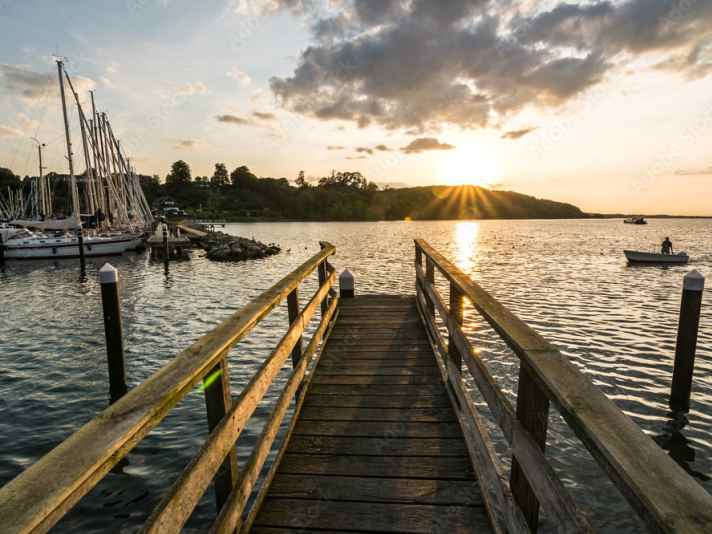
Where the Flensburg Outer Fjord narrows, the Langballigau marina is located on its southern shore. At first glance, it may seem labyrinthine and confusing. But once you have found a spot, the charm of this quaint and cosy place quickly becomes apparent. It was built around 1920 as a fishing harbour. Fishermen still sell their catch directly from the cutter here today. Despite the secluded location, everything else is taken care of: there is a small shop with accessories, restaurants and a barbecue area where you can round off a day's sailing in the company of other crews. A stroll along the jetties and a look at the boats is of course also a must!
If the weather is fine, the neighbouring natural beach with beach chair hire invites you to take a dip in the clear fjord. If you have bikes with you, you can set off from Langballigau to explore the rolling hills of Schleswig-Holstein or cycle to the centre of Langballig. This is just under two kilometres inland. Above all, however, you are protected here - Langballigau is even an emergency harbour with a stationed rescue cruiser.
My highlight in Langballigau
Being far away from everything and yet being completely catered for is what makes this harbour so appealing to me. Sitting in the cockpit enjoying the atmosphere or going on excursions in the tranquil natural surroundings along the fjord shore - you can't get more relaxing than that!
Kristina Müller
Arnis - a small town on a grand scale
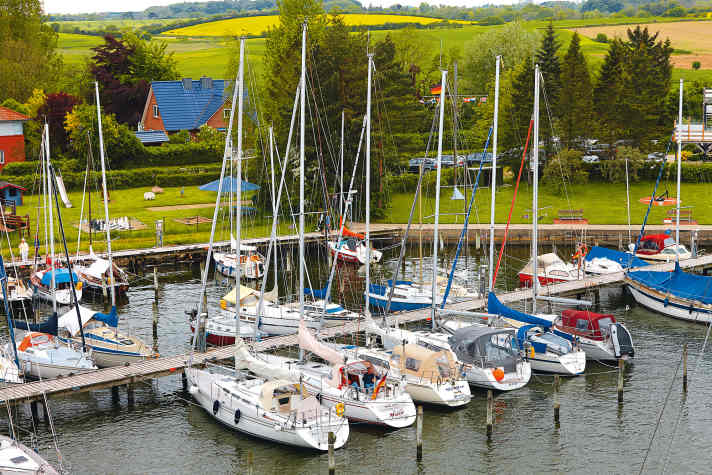
It is six miles up the Schlei to Arnis. The inhabitants have always been a close-knit group of people, known for their desire for independence. This is so great that Arnis still enjoys the status of a town today - the smallest in the whole of Germany. The pretty harbour of the Arnis/Grödersby water sports community forms the epicentre of what I consider to be the most beautiful place on the Schlei. The jetties, with their 265 berths, are tucked away in the Noor harbour and are usually perfectly sheltered from the wind. It is very cosy there, with nice barbecue areas by the water, good service and the super-nice harbour masters Achim Jensch and Andreas Sorichter (Tel. 04642/44 21). The harbour can be reached via a small buoyed channel. The bascule bridge of Kappeln must be passed beforehand - opening 15 minutes before the hour. Every Wednesday from 17:55 there is a regatta on the Schlei: a spectacle! Or you can watch the ferry traffic. Also nice: cycle through fields and meadows to Kappeln on a hire bike.
My highlight in Arnis
As a food-loving travel editor, I am drawn to the terrace of the restaurant "Spechts Speisewirtschaft", one of the best in the region, with a fantastic view of the Schlei. At weekends and during the season, be sure to book in advance (04642/983 48 63)! An alternative is the "Strandhalle". For cake, we recommend the "Schleiperle", a wonderful café on stilts in the water.
Andreas Fritsch
Flensburg - golden light at the end of the fjord
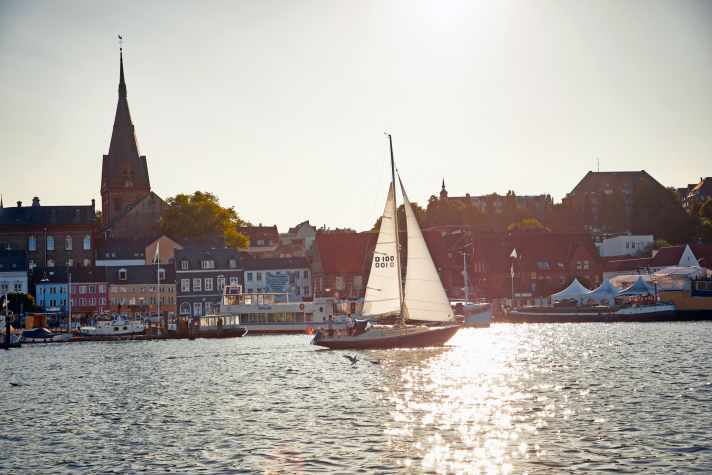
Into the low sun, always heading west: admittedly, the outward and return journeys are long, and one is often a cross, but it's worth the effort. The course leads around 25 miles through the increasingly narrow and beautiful fjord. The best place to moor the boat is in the city marina run by harbour operator Jaich. It is located directly in the city centre. From here, it is only a short walk to the truly picturesque old town. The combination of the quaint museum harbour with the working boats on the north bank and the Yachting Heritage Centre for "dignified pleasure sailing" on the south bank is also perfect. Both are cult addresses for sailors. A restaurant tip for fish fans is the "Piet Henningsen".
My highlight in Flensburg
The rum regatta of classic workboats and yachts is a must-see once in a lifetime. The atmosphere in the harbour is unique every time. The prize for the second-placed crew is - nomen est omen - a bottle of rum. Incidentally, its history is excellently described in the city's rum museum.
Andreas Fritsch
Kühlungsborn - deep-sea feelings for a sundowner

There are several attractions that justify a visit here. The long sandy beach, for example, which stretches almost to the horizon to the west and east of the harbour. The pier, where you can stretch your legs after a long cruise. The location of the marina, which is the first major port of call on the Mecklenburg-Vorpommern coast when travelling from Fehmarn, the Bay of Lübeck or Gedser in Denmark - or the last logical stopover on a westerly course towards Heiligenhafen.
On beautiful summer days, all of this inevitably leads to a large number of guest yachtsmen. With a little creativity, however, you can always find a place for your boat in Kühlungsborn - and a pub ashore for the hungry crew. On the slightly elevated harbour promenade, which is lined with restaurants, ice cream stands and cafés, it can get lively as yachties and tourists bustle around. You have to like that. To get a table with a view of the harbour, you usually need a reservation in advance, or patience and composure.
The panorama from up there is unique. That alone is worth the detour. Because nothing but sea stretches for miles in front of the pier. No harbour on the southern Baltic Sea conveys such a deep-sea feeling. It's hard to say which is more beautiful: watching the sun go down or sticking your nose into the wind in a strong north-westerly wind. Both are best!
My highlight in Kühlungsborn
Enjoy an aperitif or sundowner on the wooden benches in front of the "Vielmeer" restaurant. Sometimes a live band plays, sometimes there are chilled music streams. This is a great way to while away the time until dinner. If you bring a jumper and jacket, you can also sit and enjoy the view into the night.
Jochen Rieker
Krummin - as if not of this world
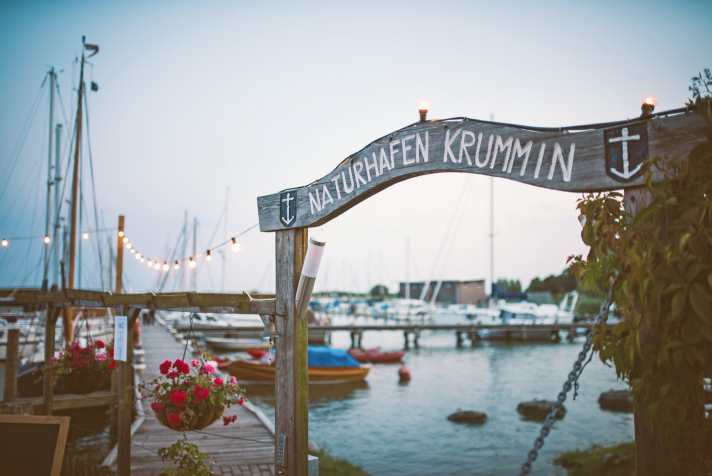
Not many marinas on the Baltic Sea are as idyllic, as remote, as lovingly designed and run as the natural harbour. If you are looking for something really special, you should not shy away from travelling the long way. Krummin is located in the far east of Germany, a good six nautical miles from Wolgast and a similar distance from Usedom. The route leads from Greifswald, Stralsund or Rügen via Peenemünde, past many well-buoyed shallows. Yachts with a draught of up to 2.50 metres pass through without any problems; the Krumminer Wiek, a Bodden waterway, is also great for sailing. Above all, however, this is a place to slow down, relax and unwind. The natural harbour with four-star comfort offers space for just 150 boats and, as the name suggests, is nestled in a natural oasis.
My highlight in Krummin
Just being there would be relaxation enough. But happiness can be enhanced. On a canoe trip on the Wiek, for example, or on Saturday evenings on the terrace, when the harbour master becomes the barbecue master. Unforgettable: the "Little Harbour Festival" in July, where singer-songwriters perform live.
Jochen Rieker
Orth - Pearl in the Fehmarn Sound
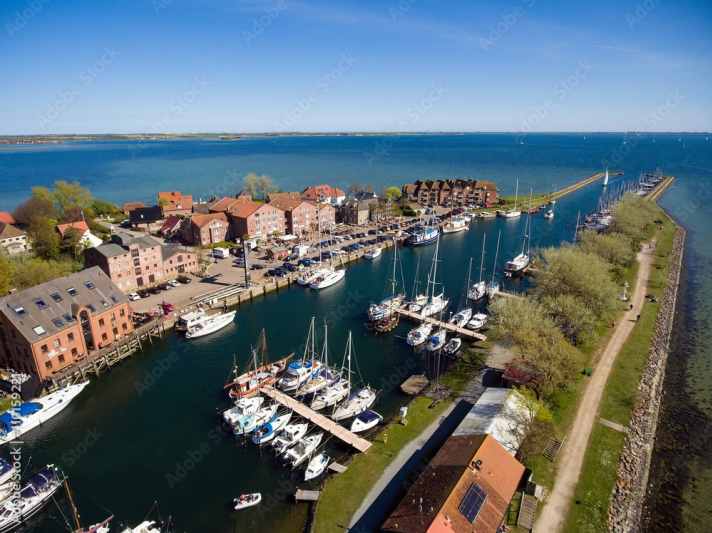
The harbour is conveniently located for stopping off on the way to or from Langeland or Ærø. This is certainly a disadvantage; some crews will remember a gruelling search for a berth at the mention of the place. Not so sailors with smaller boats. Because at the very end of the long, tubular harbour basin there are a few small boxes that the harbour master also allocates to guests. The best places are sheltered from the wind and right next to the "Kap Orth" snack bar. Here you can enjoy freshly tapped mooring beer and fish sandwiches with a beautiful view of the harbour and the bay. Kitesurfers cavort in the sheltered area, and it is not uncommon for neoprene-clad figures to come to the bar and pay for their drinks with saltwater-soaked banknotes from the sleeve of the Neo. The atmosphere is relaxed, and even if you're only at the start of your summer cruise, the holiday mood already starts here.
Directly behind "Kap Orth", the path leads onto the dyke and almost three kilometres to the Flügge lighthouse. In the evening, you walk towards the low sun. On the right, in the part of the bay separated from the dyke, the Sulsdorfer Wiek, there are thousands of seabirds, the path winds its way past a flock of sheep, while south of the bay the last kiters make their way across the glittering golden water. In addition to the natural idyll, there are also several restaurants and a bakery right by the harbour, less than two minutes away from the jetty.
My highlight in Orth
In front of the harbour, you will find beautiful anchorages in Orther Bay, well protected behind the Krummsteert peninsula. On one side, the view sweeps across the flat headland to the Baltic Sea and the lighthouse. On the other side, you can already see the Fehmarnsund Bridge. This panorama makes it clear that Orth is not just a strategically favourable stopover on the way to Denmark, but one of the most beautiful harbours on the Baltic Sea.
Michael Rinck
Timmendorf on Poel - ready for the island
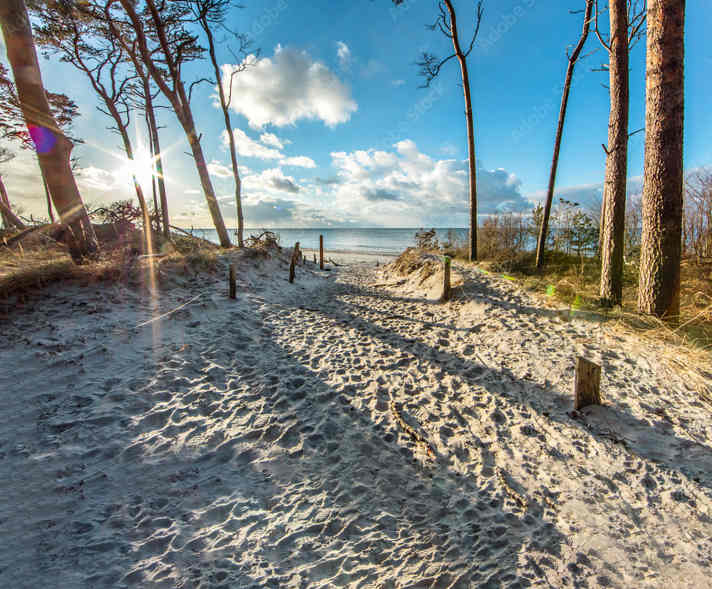
The small fishing and pilot harbour at the entrance to Wismar Bay is a gem nestled in impressive natural surroundings. But be careful! For those not familiar with the area, there is a risk of confusion with Timmendorfer Strand in Neustädter Bucht. The harbour on the island of Poel is secluded between the beach and the cliffs. The white sand begins just behind the pier to the north and stretches for many kilometres to the north of the island. The beach is very well maintained, there are beach chairs and a sailing school rents out small catamarans. South of the harbour, the exact opposite: trees that have fallen from the rapidly eroding cliffs lie in the way, stones washed out of the yellow cliffs litter the shallow water, with greenery growing in between - a natural paradise. But it's not just along the coast that a walk is worthwhile. From Timmendorf, it is just over four kilometres across the island to Kirchdorf with its small harbour, a brick church and the remains of an old fortress. There is an Italian restaurant and several fish restaurants. Bread rolls for breakfast are available from the bakery, and souvenirs and some groceries can be found in the sea chest next door. The only drawback: when the wind blows from the south-west, there is swell in the guest areas.
My highlight in Timmendorf
Enjoy a sundowner less than ten metres from the bow of your own boat on the beach or on the pier. The west-facing orientation of the harbour means you can watch spectacular sunsets here. There is also an anchorage a little to the south, well protected from easterly winds.
Michael Rinck
Stralsund - a maritime microcosm
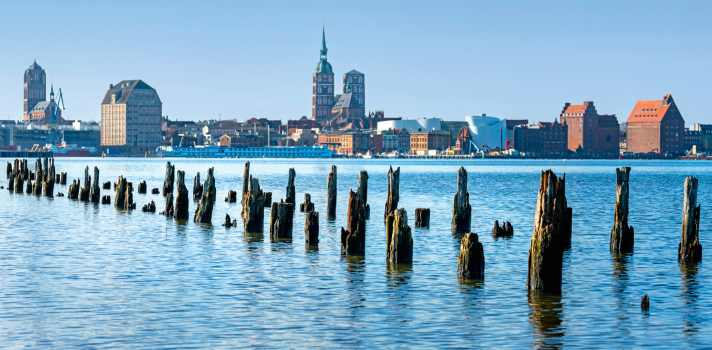
If the Hanseatic cities on the German coast from Bremen to Wismar to Greifswald are historical, architectural, cultural and culinary highlights per se, Stralsund is for me the secret queen among them. This is largely due to its unique location: sailors can reach the settlement on the Strelasund via the Baltic Sea and the fairways between the Rügen coast and the Pomeranian mainland or from the south via the beautiful sound after the Ziegelgrabenbrücke bridge has opened. The journey there is a destination in itself, and thanks to the many small harbours along the way, it can be excellently parcelled out.
From Stralsund, you can round Rügen with its highlights such as the picturesque rock formations of Stubbenkammer and Cape Arkona, head for the sandy island of Hiddensee with its contrasting shallow waters or reach more remote areas such as southern Sweden or Bornholm after ambitious day trips.
But the highlight remains Stralsund itself, a Unesco World Heritage Site. Sailors can moor in the large marina overlooking the historic town centre or even more centrally, lively and narrow in the canals surrounding the harbour island, which can only be reached after passing swing and bascule bridges. The Hanseatic city and all its amenities are within easy reach, and even those who are lazy on foot will not want to escape the flair of the historic walls after a stroll through the streets and alleyways.
The maritime centre is the harbour island, where the "Gorch Fock I" is moored and can be visited. 200 metres next door is the modern Ozeaneum, a mixture of aquarium and maritime museum that is well worth a visit. The banks are paved with restaurants and pubs of all kinds - and yet the Citymarina is quite quiet and, although close to the city, almost in the middle of nature with a view of Rügen. Stralsund thus offers a maritime microcosm. In my opinion, this is a mixture that is both ideal and rare and definitely belongs on a sailor's bucket list.
My highlight in Stralsund
Just as sailing combines tradition and modernity, you can take a walk through the cultural history of the harbour pub in Stralsund: The "Zur Fähre", supposedly the oldest maritime pub in Europe, is located in Fährstraße. The "Brazil", a modern cocktail bar popular with local sailors, is located directly on the Querkanal.
Fridtjof Gunkel
Schleimünde - an island with a connection

The pilot island at the mouth of the Schlei estuary between Kiel and Flensburg Fjord is, so to speak, the Baltic Sea equivalent of a North Frisian Hallig: only accessible by boat (the peninsula's land connection is a nature reserve), underserved (no water, no waste collection, no shop), overcrowded with tourists during the day in the season (travelling by excursion steamers). And yet, the island's laid-back atmosphere, the relative peace and quiet, the supposed seclusion despite its proximity to the mainland combine to create an unrivalled flair. This is topped off in the evening at sunset, when the barbecues near the small beach blaze up or the crews relax in front of the "Giftbude" pub and watch the yachts entering the Schlei. In the season, it can get crowded at the weekends, but somehow there is always room alongside or for two in the box.
My highlight in Schleimünde
No electricity, no neighbouring boats, no people: an overnight stay outside the sailing season is incomparable. Seabirds and the sound of the surf are the only noises, the nearest light sources are far away and the view of the starry sky is unique.
Ursula Meer
Warnemünde - turning point on the Alter Strom
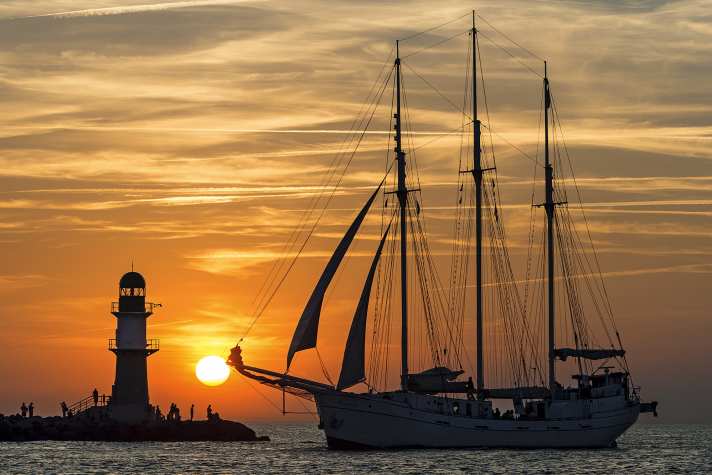
Behind the stately harbour entrance with its wide open piers and photogenic peat fires lies the narrow Alte Strom - once an important trade route, today a dead end with a manageable number of moorings. Old fishing boats are lined up along the pier. On land, it is lined with colourful little houses with curved gables and glazed verandas. The promenade is bustling with small shops and restaurants. On the east side, however, there is little to see for strollers, where you can moor your yacht quietly at the clubs - or in the new harbour on the central pier. When your eyes fall on the bright red wooden cutter called "Zufriedenheit" (Satisfaction) as you sip your morning coffee in the cockpit, the day has a motto. The distances are short, whether to the fish sandwich from the cutter or to the dunes in front of stately manor houses from a time when people still went on summer holidays. The "Neptun" hotel, a prefabricated building in fresh colours with hip beach bars in front of it, watches over the wide beach in an old-fashioned way: The Alte Strom and its surroundings are history in fast motion.
My highlight in Warnemünde
The lighthouse on the beach is open to the public. Admission costs three euros, the view: priceless. After climbing 135 steps, you can enjoy a spectacularly beautiful view over the city, the coast on both sides of the Warnow estuary and the sea.
Ursula Meer
Heiligenhafen - boomtown with unobstructable nature conservation magic
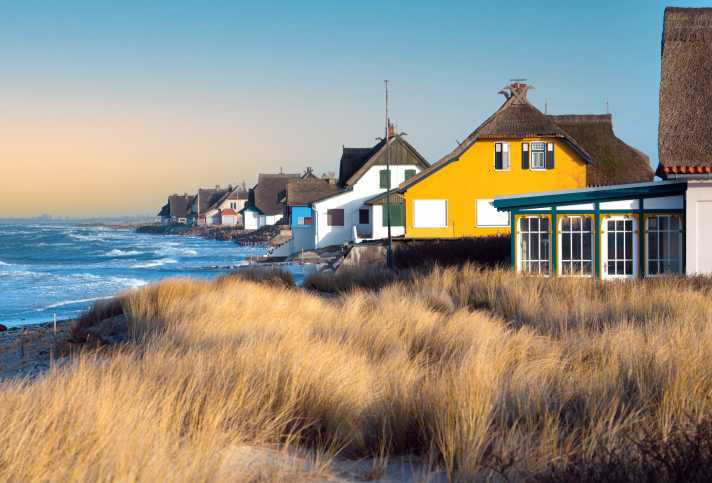
Nowhere else on the German Baltic coast has there been so much digging and building in the past ten years as in the once somewhat sleepy town south of Fehmarn. Holiday homes, hotels, pier, pubs - there seems to be no stopping Heiligenhafen. If you want to get from the car park to the boat with your luggage in summer, you now have to find gaps in the stream of strolling tourists to get to the jetties.
That is one side of the boom. On the other hand, the city and marina have gained enormously in diversity as a result. Hardly anywhere else is the infrastructure and supply as good as here, and the gastronomic offerings are as varied - from home-style food such as the "Strandläufer" or the "Altdeutsche Bierstube" to the finest sushi with a harbour view at "Tamatsu". Architecturally, too, Holy Harbour offers what hipsters call an exciting mix of modernity and old village centre. A persistent cold front or tough calm days can be easily sat out here, especially as the beach and Graswarder set limits to urban development ambitions. As a result, Heiligenhafen is still a haven for nature lovers.
My highlight in Heiligenhafen
The Graswarder peninsula with its old, windswept cottages is my favourite scenic spot. In culinary terms, I really like Katja and Robert's "Marina Crêpes" on the pier promenade. There are - of course - crêpes, both sweet and savoury and always imaginatively composed, but also ice cream and the most delicious coffee far and wide.
Nadine Timm
Rerik - between binnen and buten
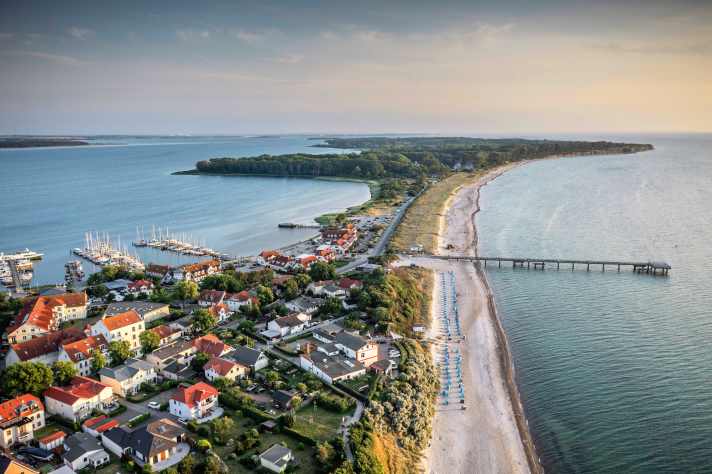
This aerial photo says it all. It shows a doll's house village surrounded by water from both north and south - well-kept houses, trimmed hedges, winding lanes and paths. A dream beach on the seaward side, a bay lined with headlands, wild forests and fields on the inland side, and the island of Poel in the background. This is Rerik, one of the least known of the Baltic Sea's very special harbours.
The fact that only a few owners and charter crews find their way here is certainly not due to the area's lack of appeal. Rather it is due to the sometimes tricky approach. The route to Mecklenburg's Bullerbü leads across sometimes treacherous sands and shallows, which are also only sparsely buoyed. But it is worth taking on the navigational challenge.
Particularly in fresh westerly or north-westerly winds, you experience a bizarre change of scenery when entering the Reriker Bodden from the south: whereas just a moment ago there were whitecaps and choppy seas, everything suddenly becomes calm and peaceful beyond the keel. As if you could switch from high seas to inland seas at the touch of a button.
It's an exhilarating experience because you can suddenly take in the loveliness of the landscape on this side of the Salzhaff with all your previously fully engaged synapses - at least one and a half nautical miles on course 040 degrees, until you have to hit one of two channels through the one-metre flat in the middle of the "Ellenbogen".
Water depth also plays a role in Rerik harbour. Boats with a draught of two metres or more can only moor at the eastern jetty, and only at the head and in the first three or four boxes. If you are well moored, there are numerous places to eat within a few minutes' walk: a small village bakery by the church and a whole ensemble of mostly well-frequented restaurants between the harbour and the Baltic Sea beach.
If you want to explore the town and the surrounding area, you should walk along the slightly elevated path above the beach. As a starting point, we recommend a short stop in the afternoon in the garden at the "Villa Krone", where the Graf bakery serves coffee and cake. From up there, you can see as far as the Salzhaff to the south-west and the Baltic Sea for miles to the north. An even better view can only be had from the tower of St John's Church (information on opening hours in the museum).
My highlight in Rerik
In the past two years, Rerik, like everywhere else on the German coast, has been quite crowded during peak season. This doesn't apply to the harbour, but to the town and the beautiful sandy beach - at least on and near the pier. If you are looking for peace and quiet, simply walk a few hundred metres southwest towards Wustrow. Shortly before the restricted area, the crowd thins out and you have the beach almost to yourself.
Nadine Timm
Nature and culture in Kloster (Hiddensee)
![5 pictures from the northern part of Hiddensee: View from the lighthouse to Kloster+ Vitte, view to Grieben and the lighthouse itself. DEU, Germany, Koster, 18.08.2018: Lighthouse Dornbusch | [ (c) Bodo Mueller, Reproduction only with fee, attribution and voucher copy; fee according to the current fee recommendations of the Mittelstandsgemeinschaft Foto-Marketing (MFM), unless otherwise agreed before use. Bodo Mueller, Mecklenburger Landstr.56, D-23570 Travemuende Tel. 04502/ 2669, E-Mail: info@bodo-mueller.de; www.bodo-mueller.de Taxable with 7 % VAT at the Luebeck tax office, tax no. 2215760072. Bank details: Postbank Hamburg BLZ: 20010020 Account no. 546078-202, IBAN DE65 2001 0020 0546 0782 02, BIC PBNKDEFF] [#0,26,121#]](https://media.delius-klasing.de/dk-wassersport/images/dpr_auto,fl_progressive,f_auto,c_fill,h_475,w_712/q_auto:eco/yacht/hiddensee-dornbusch-vitte-2018-bmu-2bm9822_bddf8270650327a552747b0ff9f0b98d/5-pictures-from-the-northern-part-of-hiddensee-view-from-the-lighthouse-to-kloster-vitte-view-to-grieben-and-the-lighthouse-itself-deu-germany-koster-18-08-2018-lighthouse-dornbusch-c-bodo-mueller-reproduction-only-with-fee-attribution-and-voucher-copy-fee-according-to-the-current-fee-recommendations-of-the-mittelstandsgemeinschaft-foto-marketing-mfm-unless-otherwise-agreed-before-use-bodo-mueller-mecklenburger-landstr-56-d-23570-travemuende-tel-04502-2669-e-mail-info-bodo-mueller-de-www-bodo-mueller-de-taxable-with-7-vat-at-the-luebeck-tax-office-tax-no-2215760072-bank-details-postbank-hamburg-blz-20010020-account-no-546078-202-iban-de65-2001-0020-0546-0782-02-bic-pbnkdeff-0-26-121-)
On my first visit to the northernmost harbour of the enchanting island, shortly after reunification, guest moorings for pleasure craft were rare. They moored at the bulwark or between fishing boats. The sailing harbour has only been a marina in Kloster since 2015. Fortunately, it has not taken away any of the town's charm, but still offers its guests everything their hearts desire. The harbour master can help you find a berth in the often overcrowded harbour. The town itself is tranquil, with a few shops, restaurants, art galleries and an amber-cutting workshop in the centre - all within walking distance of the jetties. As small as the village is, Kloster can certainly be described as Hiddensee's cultural centre. Whether it's the island church, the Gerhart Hauptmann House or the local history museum, there is plenty to discover. The bathing beach on the western shore is also not far away, as "Dat söte Länneken", as the island is called by the locals, is narrow at this point. Quite a few water tourists therefore book themselves into Kloster for their entire holiday.
My highlight in Kloster on Hiddensee
The harbour's location is its attraction. The picturesque village, the unspoilt beach, the excursion destinations - everything is within easy reach. An absolute must for me is a walk to the Dornbusch lighthouse with a stop at the historic "Zum Klaussner" inn.
Lasse Johannsen
Lippe - a gem in the middle of nowhere
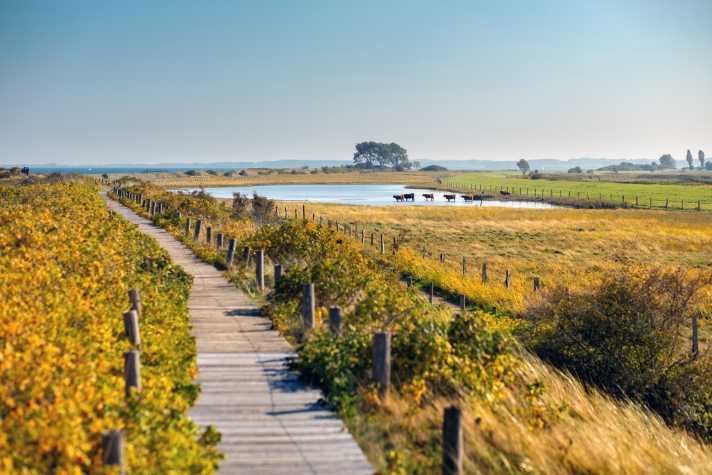
For a long time, this enchanted place was a blank spot on my nautical map. The journey to the harbour leads through the Putlos and Todendorf restricted areas and is only possible outside of shooting times. There is also a sandbank in front of the harbour. The channel leading into the harbour has to be dredged regularly. Information about the current water level can be obtained from the harbour master on 0152/53 86 78 34.
My highlight in Lippe
The harbour is located on Hohwacht Bay in the middle of unspoilt nature and beautiful sandy beaches. Despite its seclusion, it offers the usual catering facilities and restaurants - from the rustic harbour snack bar to the upmarket "Klabautermann" restaurant with sea views.
Lasse Johannsen

